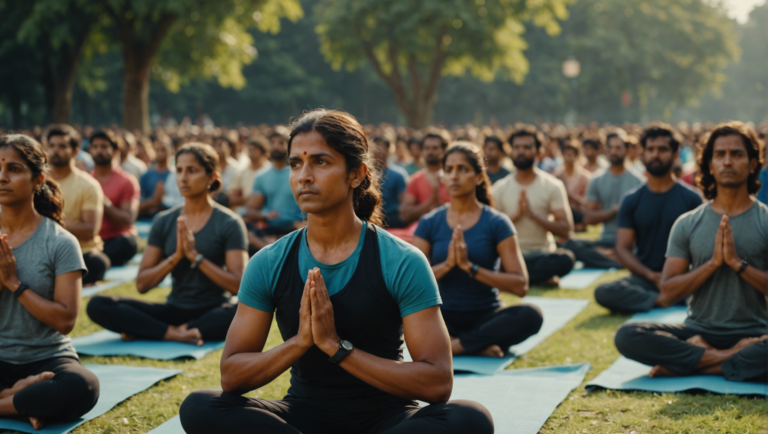Discovering The Best Places To Learn Yoga In India
Discovering the Best Places to Learn Yoga in India: A Journey Inside and Out
Embarking on a transformative journey through the ancient practice of yoga in its birthplace, India, offers not just a pathway to physical well-being but also an exploration of inner peace and spiritual growth. This sacred quest leads us to some of the most revered destinations known for their unparalleled contribution to yoga teaching and philosophy.
Unveiling the Spiritual Essence of Rishikesh
Nestled along the serene banks of the Ganges, Rishikesh not only boasts its title as the world’s yoga capital but also serves as a gateway to the Himalayas. It’s a place where the air carries the echo of chanting mantras, and the surroundings are imbued with a profound spiritual presence. The Sivananda Ashram, found here, is renowned for its traditional approach and comprehensive teaching methods that cover all aspects of yoga, including meditation, asana practice, and Vedanta philosophy. This approach fosters a holistic understanding of yoga, much beyond the physical postures.
The Ancient Wisdom of Mysuru
Mysuru (formerly Mysore), a city with royal heritage, is another cornerstone in the yoga pilgrimage across India. It’s here that Ashtanga Yoga finds its roots under the tutelage of the late Sri K. Pattabhi Jois. His institute, the Ashtanga Yoga Research Institute, continues to attract yoga enthusiasts from across the globe, eager to delve into the rigorous discipline of Ashtanga’s series of postures. The practice here is characterized by its emphasis on vinyasa, or the seamless flow between postures, guided by the breath. This discipline not only cultivates physical strength and flexibility but also mental clarity and focus.
The Introspective Path of Bihar
The Bihar School of Yoga, situated in Munger, Bihar, presents a contrasting approach to the physicality of yoga. It emphasizes Pratyahara (withdrawal of senses) and Dhyana (meditation), guiding practitioners to an introspective journey towards self-realization. This school is pivotal for those seeking to deepen their understanding of the psychological and spiritual dimensions of yoga. Its teachings are grounded in ancient scriptures yet tailored to address the challenges of the modern psyche, creating a balance between traditional wisdom and contemporary life.
The Vedantic Teachings of Coimbatore
The Isha Yoga Center in Coimbatore, founded by Sadhguru, stands as a beacon of spiritual awakening amidst the verdant foothills of the Velliangiri Mountains. Its approach is heavily influenced by the non-dualistic philosophy of Advaita Vedanta, advocating for a yogic practice that transcends physical methodologies to include inner transformation and self-inquiry. The center is famous for its intensive residential programs, particularly the Inner Engineering retreat, which combines asanas, meditation, and the Shambhavi Mahamudra Kriya—techniques aimed at harmonizing body, mind, and energy.
The Heart of Goa’s Yoga Community
The radiant shores of Goa offer not just a tropical paradise but also a thriving hub for yoga practitioners. Here, the focus is on a balanced lifestyle that integrates yoga with nature, community, and wellness. The numerous retreats and schools, such as the Purple Valley Yoga Center, specialize in various styles, including Hatha Yoga, Vinyasa, and Iyengar Yoga. They offer an environment that nurtures personal growth and healing, set against the backdrop of Goa’s stunning landscapes.
Embarking on a journey to learn yoga in India is much more than mastering asanas; it’s about embracing a way of life that aligns with ancient wisdom and spiritual practice. Each of these destinations offers a unique pathway into the depths of yoga, encouraging a transformative experience that resonates within the soul. Whether driven by a quest for physical health, mental clarity, or spiritual awakening, India’s sacred spaces welcome all who seek to explore the profound dimensions of yoga. This exploration is not just an external travel across the vibrant tapestry of India but also an inward voyage towards self-discovery and enlightenment.
The Historical Roots of Yoga in India and Their Influence on Modern Practices
Yoga, an ancient practice rooted deeply in the rich soil of India’s spiritual tradition, has evolved significantly over the millennia. Its journey from the mysterious caves and forests of the subcontinent to the polished floors of modern studios around the world is a testament to its universal appeal and adaptability. This dynamic evolution of yoga is not just a tale of physical postures and breath control; it is a narrative of philosophical, spiritual, and cultural intertwining that has shaped not only the practice itself but also the lives of millions of practitioners across the globe.
The Dawn of Yoga: Unveiling Ancient Traditions
The origins of yoga trace back over 5,000 years in India, with the Indus-Sarasvati civilization being credited for its earliest practice. The word "yoga" itself, derived from the Sanskrit root "yuj," means to join or to unite, symbolizing the ultimate goal of achieving a union between the individual self and the universal consciousness. The ancient scriptures, including the Vedas, Upanishads, and the seminal Bhagavad Gita, outline the philosophical framework of yoga, emphasizing its role in fostering detachment, discipline, and a spiritual connection to the divine.
The teachings of revered sages, such as Patanjali, who compiled the Yoga Sutras around 400 CE, crystallized the practice into an eight-limbed path (Ashtanga Yoga). This path offers a systematic approach to purifying the body and mind, leading to self-realization and enlightenment. Patanjali’s influence is profound, with his aphorisms still forming the core of yoga philosophy and practice today.
The Fusion of Tradition and Modernity
As yoga meandered through history, it encountered various interpretations and adaptations. The medieval era introduced Tantra Yoga, which sought to use the body as a means of spiritual enlightenment, highlighting the interconnection between the physical and the metaphysical. This period also saw the development of Hatha Yoga, focusing on physical postures (asanas) and breath control (pranayama) to prepare the body for meditation and spiritual awakening.
The transition of yoga into the modern era was marked by a blend of traditional practices with contemporary health and wellness trends. The global dissemination of yoga in the 20th century, spearheaded by pioneers such as Swami Vivekananda, B.K.S. Iyengar, T. Krishnamacharya, and Paramahansa Yogananda, introduced the Western world to its physical, mental, and spiritual benefits. This globalization led to an exponential increase in the popularity of yoga, with it being adapted to suit the needs and lifestyles of practitioners in different parts of the world.
The Impact on Contemporary Yoga Practices
The historical roots of yoga in India have a profound impact on contemporary practices. Modern yoga, while diverse in its forms—ranging from the vigorous Ashtanga to the gentle Hatha, or the precise alignment-focused Iyengar, to the restorative Yin—still retains the essence of its ancient philosophy. The emphasis on mindfulness, breath control, and the pursuit of inner peace and self-realization are threads that run through all varieties of modern yoga.
Furthermore, the resurgence of interest in traditional forms of yoga, meditation retreats, and spiritual tourism in India signifies a growing appreciation for the authenticity and depth of the practice. This has led to a fusion of cultures, where ancient Indian wisdom meets modern needs, creating a vibrant, global community of yogis.
Navigating the Future: The Legacy Continues
As yoga continues to evolve, its ancient roots provide a foundation that ensures its integrity and vitality. The practice’s historical journey reminds us that yoga is not merely a physical exercise but a rich, cultural heritage that offers profound insights into the human condition. By honoring its origins and embracing its transformations, yoga remains a timeless practice that nurtures mind, body, and spirit, bridging past, present, and future.
The legacy of yoga in India, with its emphasis on unity, spiritual growth, and holistic well-being, continues to influence and inspire modern practices. As we navigate the complexities of contemporary life, the ancient wisdom of yoga offers a compass, guiding us towards a path of balance, harmony, and enlightenment.
Comparing Traditional Ashrams with Modern Yoga Retreats in India
India, the birthplace of yoga, offers a wide array of experiences for those seeking to deepen their practice or embark on a journey of self-discovery. The debate between traditional ashrams and modern yoga retreats in India is emblematic of a broader conversation about the essence of yoga and the balance between its ancient roots and contemporary adaptations. Exploring these pathways can provide valuable insights and help practitioners make informed decisions based on their personal objectives and inclinations.
The Essence of Traditional Ashrams
Traditional ashrams in India are immersive environments designed for spiritual growth and self-discipline. Here, life revolves around a rigorous schedule that includes early morning meditations, multiple yoga sessions, karma yoga (selfless service), and satsang (spiritual discourse). This setup aims to guide individuals toward a holistic understanding of yoga’s physical, mental, and spiritual dimensions.
Ashrams offer an opportunity to retreat from the distractions of daily life and delve into the depths of Vedic wisdom. They operate on the principles of simplicity and austerity, mirroring the ascetic lives of yogis who pursue enlightenment. The experience is not just about mastering asanas but encompasses learning about breath control (pranayama), meditation, and the philosophical underpinnings of yoga.
The teachings at these institutions often reflect the lineage and ideology of the founding guru. This ensures continuity of the traditional practices and philosophies handed down through generations. For those seeking an authentic and transformative experience, ashrams provide a direct link to yoga’s ancient roots.
Navigating the World of Modern Yoga Retreats
In contrast, modern yoga retreats in India offer a more relaxed and accessible approach, catering to the needs and comforts of participants from diverse backgrounds. These retreats blend the physical practice of yoga with other wellness modalities, such as spa treatments, nutritional coaching, and alternative therapies. The setting is typically more luxurious, with amenities that ensure a comfortable stay.
The curriculum at modern retreats is often more flexible, allowing participants to choose how deeply they wish to engage with the traditional aspects of yoga. While there is still an emphasis on practice and learning, the experience is tailored to also provide relaxation and rejuvenation. This approach makes yoga more approachable for beginners or those who wish to balance their spiritual practice with leisure.
Modern yoga retreats are ideal for individuals looking to escape the stresses of modern life, offering a sanctuary to recharge and refocus. They serve as gateways to the world of yoga, potentially sparking deeper exploration.
Choosing Your Path: Alignment of Intentions
The choice between a traditional ashram and a modern yoga retreat hinges on personal intentions and what one seeks from the practice. Those drawn to the austere, disciplined life of an ashram are likely in search of spiritual deepening and a profound transformation. The ashram environment fosters a sense of community and shared purpose, with a focus on personal development and self-awareness.
Conversely, modern retreats provide a more accessible entry point for individuals at the beginning of their yoga journey or those seeking a blend of relaxation and practice. The emphasis on comfort and personal space allows for a gentle introduction to yoga’s benefits without the intensity of ashram life.
Understanding the Impact on Your Journey
Regardless of the path chosen, the journey into yoga is deeply personal and can be profoundly life-changing. Traditional ashrams offer a window into the soul of yoga, demanding commitment and openness to transformation. Modern yoga retreats, on the other hand, provide a nurturing space to explore yoga in a manner that respects individual boundaries and comfort levels.
In navigating the choice, consider your goals, the depth of immersion you seek, and the level of challenge you are prepared to embrace. Whether through the disciplined lifestyle of an ashram or the rejuvenating environment of a modern retreat, India offers unparalleled opportunities to explore the multifaceted world of yoga. The journey, whichever route it takes, promises growth, discovery, and a deeper connection with the self.
The Holistic Benefits of Immersing Yourself in an Authentic Yoga Experience
Yoga, an ancient practice rooting back thousands of years in India, has transcended its geographical origin to become a global phenomenon. Yet, the essence of engaging in this holistic discipline amidst its birthplace offers unparalleled depth and authenticity. The benefits of delving into this authentic yoga experience are multifaceted, encompassing physical, mental, and spiritual well-being. By immersing oneself in the traditional yogic lifestyle, practitioners gain access to profound transformative experiences that extend beyond the mat and permeate every aspect of life.
Embracing the Physical Journey Through Traditional Practices
Engaging in yoga at its source allows individuals to explore a wide array of styles and teachings that may not be readily available elsewhere. This includes not just the physical postures or asanas but also the nuanced techniques of breath control (pranayama) and purification practices (shatkriya) that enhance physical health and vitality. The art of aligning breath with movement in practices such as Ashtanga or Vinyasa offers a deep physical conditioning that improves flexibility, strength, and stamina. Meanwhile, therapeutic forms like Iyengar yoga, with its focus on alignment and the use of props, can offer profound healing benefits for both chronic and acute conditions.
Nurturing the Mind: Meditation and Mindfulness
The journey of yoga is deeply intertwined with the practices of meditation and mindfulness. By studying in India, practitioners have the unique opportunity to learn meditation from seasoned gurus who have mastered the art of silencing the mind and achieving states of profound peace and clarity. These practices are integral to the yogic lifestyle and foster a sense of inner tranquility that combats stress and anxiety, promoting mental health and cognitive clarity. The immersive experience in traditional settings often includes lessons on ancient scriptures such as the Yoga Sutras of Patanjali, offering insights into the philosophical underpinnings that support a mindful approach to living.
Spiritual Growth and Self-Realization
Perhaps the most profound aspect of engaging in an authentic yoga experience is the journey toward spiritual growth and self-realization. Yoga, in its essence, is a spiritual practice aimed at the union of individual consciousness with universal consciousness. The spiritual teachings of yoga provide a roadmap for navigating the complexities of life with compassion, detachment, and equanimity. Practitioners are guided towards self-inquiry and contemplation, fostering a deep connection with the self and the divine. This path of spiritual exploration encourages a holistic perspective on life, where happiness and contentment arise from within.
Community and Cultural Immersion
The experience of practicing yoga in its homeland is enriched by the vibrant cultural context and the sense of community that surrounds it. Participating in festivals, ceremonies, and daily rituals offers a glimpse into the rich tapestry of Indian culture, where yoga is a way of life. This immersion in a different cultural paradigm provides valuable lessons on simplicity, gratitude, and the art of living in harmony with nature and others. The bonds formed with fellow yogis and the local community can be deeply enriching, adding an element of human connection that transcends cultural and linguistic barriers.
Integrating Holistic Well-being into Daily Life
The holistic benefits of immersing oneself in an authentic yoga experience have the power to transform not just individual lives but also contribute to a broader societal shift towards health, harmony, and sustainability. Through firsthand experience, practitioners learn to integrate the principles of yoga into daily life, embodying the values of mindfulness, compassion, and environmental stewardship. This integrated approach to well-being inspires a lifestyle that prioritizes balance, health, and interconnectedness, laying the foundation for a more conscious and sustainable way of living.
The journey into the heart of yoga in India is not merely an exercise regimen but a profound exploration of the human experience. It offers a transformative pathway to holistic health, inner peace, and spiritual growth, grounded in the rich soil of its ancient origins.
Navigating India: Practical Tips for Yoga Students Planning Their Journey
Embarking on a journey to learn yoga in India is an adventure that can profoundly influence both your practice and your personal growth. India, the birthplace of yoga, offers a wealth of knowledge, spiritual abundance, and diverse cultural experiences. However, navigating this vast country and optimizing your learning experience requires thoughtful planning. Here are practical tips to help yoga students plan their journey effectively.
Understanding the Different Types of Yoga Schools
India is home to a myriad of yoga schools, each offering unique philosophies, practices, and environments. Some institutions focus on physical postures (asanas), while others emphasize meditation, philosophical teachings, or a blend of spiritual practices. Research is crucial to find a school that aligns with your goals and values. Websites, testimonials, and alumni feedback can offer invaluable insights into what you can expect from your learning experience.
Selecting the Ideal Location for Yoga Studies
The location of your yoga school in India can significantly impact your study and practice. From the serene foothills of the Himalayas in Rishikesh, known as the ‘Yoga Capital of the World,’ to the tranquil beaches of Goa, each setting offers a unique ambiance. Consider whether you prefer the quiet of nature or the vibrancy of a city. Climate can also play a big role in your comfort and well-being, so consider the seasonal temperatures and rainfall patterns of your chosen location.
Budgeting for Your Yoga Journey
Budgeting for your yoga journey in India involves more than just tuition fees. Accommodation, food, local transportation, and incidental expenses can vary widely depending on the location and your personal needs. Many schools offer all-inclusive packages, which can simplify budgeting. Still, it’s essential to factor in additional costs such as international airfare, tourist attractions, and souvenirs. Planning and budgeting wisely can ensure that financial concerns don’t distract from your learning and experiences.
Visa Requirements and Legalities
Navigating the visa process is a crucial step in planning your yoga journey to India. Most students will require a tourist visa, which is relatively straightforward to obtain but comes with stipulations regarding the duration of stay and extensions. Depending on your course length, you may need to explore student visa options, which involve more stringent documentation and approvals. Always check the latest visa regulations and application procedures to avoid any legal complications.
Preparing for Cultural Integration
Immersing yourself in India’s rich cultural tapestry can be one of the most rewarding aspects of your yoga journey. Familiarizing yourself with basic etiquette, customs, and a few phrases in the local language can enhance your experience and foster connections with teachers and fellow students. Understanding cultural norms regarding clothing, dining, and social interactions can also help you navigate your stay with respect and sensitivity.
Health and Safety Considerations
Maintaining your health and safety is paramount during your yoga journey in India. Comprehensive travel insurance, covering both health and possessions, is essential. Be mindful of food and water hygiene to avoid common travelers’ ailments. Vaccinations for certain diseases might be recommended or required, so consult with a travel health specialist well in advance of your trip.
Embracing Your Yoga Journey with Openness and Flexibility
Approaching your yoga journey with an open heart and mind can profoundly influence your learning experience. Remain flexible and open to the unexpected. Challenges and surprises are part of the adventure and can lead to personal growth and deeper insights into your yoga practice.
Your journey to learn yoga in India is not just about deepening your practice but also about embarking on a transformative path of self-discovery. With careful planning, openness to new experiences, and a respectful embrace of India’s cultural diversity, your yoga journey can be an enriching, life-altering adventure.
Conclusion
Embarking on a quest to find the best places to learn yoga in India is more than a simple journey; it’s an odyssey that delves into the deepest realms of self-discovery and spiritual enlightenment. This voyage not only reconnects individuals to the ancient praxes that originated thousands of years ago but also exposes them to a spectrum of yoga practices, ranging from traditional ashrams to modern retreats. Each option offers a unique path to mastering yoga, whether through classical methodologies fostered in serene ashrams or contemporary approaches embraced within the luxurious confines of modern retreats.
Understanding the historical roots of yoga in India is crucial for any student of the discipline. It provides a deeper appreciation of the practices and philosophies that form the bedrock of modern yoga. This ancient tradition, etched in the spiritual psyche of India, offers more than just physical postures and breathing techniques; it is a way of life that encompasses moral and ethical guidelines, meditation, and a quest for enlightenment. Engaging with yoga at its source allows practitioners to experience the authenticity and depth of these teachings in a way that is rarely replicated outside its borders.
The choice between traditional ashrams and modern yoga retreats in India is significant, reflecting a broader decision between immersion in the ascetic lifestyle of yogic philosophy and a more balanced integration of yoga with worldly comforts. Ashrams, often set in tranquil locations conducive to meditation and reflection, provide an austere, immersive experience. This environment is ideal for those seeking to delve deeply into the spiritual and philosophical aspects of yoga. In contrast, modern retreats offer an accessible blend of traditional practices with the amenities and comforts of contemporary living, appealing to those who may seek a holistic experience without significant lifestyle adjustments.
The holistic benefits of immersing oneself in an authentic yoga experience in India cannot be understated. Such an experience offers profound transformations in physical health, mental clarity, and spiritual growth. Beyond the mastery of asanas and breathing techniques, students often report a newfound sense of peace, resilience, and connectivity with the surrounding world. The lessons learned on the mat transcend physical boundaries, influencing lifestyle choices, relationships, and perceptions of oneself and the universe.
For those drawn to this path, practical guidance for navigating India is indispensable. A journey of this magnitude requires thoughtful preparation, from selecting the right school or retreat to understanding cultural nuances and logistical considerations. Potential challenges, such as navigating local transportation, dietary changes, and cultural adjustments, are far outweighed by the rewards. Yet, it’s the mindful approach to planning and openness to the unfolding experience that often determines the richness of one’s yoga journey in India.
This exploration—from the discovery of ideal learning locales to the practicalities of undertaking such a transformative journey—highlights that learning yoga in India is far more than acquiring new poses or mastering breathing techniques. It is an invitation to partake in a time-honored tradition that enriches the body, enlightens the mind, and elevates the spirit. Those who embark on this path do not merely learn; they transform, embodying the essence of yoga in every aspect of their lives.
Whether one is drawn to the serene discipline of an ashram or the inclusive approach of a modern retreat, India offers a mosaic of paths leading toward self-discovery and spiritual awakening. The journey to learn yoga in India, therefore, is not just about discovering the best places but also about uncovering layers of one’s self, fostering a profound connection between mind, body, and soul that resonates far beyond the mat. As each practitioner navigates this journey, they weave their own narrative into the vast tapestry of yoga’s enduring legacy, contributing to its global mosaic while charting a course toward personal enlightenment and well-being.





